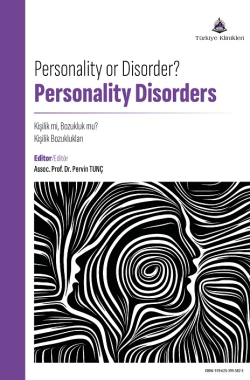Understanding Paranoid Personality Disorder According to Psychodynamic Theory
Pervin TUNÇa
aİstinye University Faculty of Humanities and Social Sciences, Department of Psychology, İstanbul, Türkiye
Tunç P. Understanding paranoid personality disorder according to psychodynamic theory. Tunç P, ed. Personality or Disorder? Personality Disorders. 1st ed. Ankara: Türkiye Klinikleri; 2025. p.1-9.
ABSTRACT
Paranoid Personality Disorder (PPD) is a chronic psychological problem characterized by excessive suspiciousness and vigilance, cognitive rigidity, grandiosity, negative affect, aggression, hostile tendencies, and expectations of being harmed. Individuals with this disorder experience conflicts in socialrelationships due to hoarding of injustices, lack of humor, distrust, pathological jealousy, and obsessive justice-seeking behaviors. Diagnosis of this disorderis often besetwith confusion due to its apparent similarities with other psychopathologies. The disorder has been neglected by scientific research due to the afflicted individuals’ reluctance to seek treatment and negative clinical treatment outcomes. Historically, the psychodynamic approach has played an important role in understanding personality disorders. In PPD cases, promising explanatory approaches have been developed, and clinical observations made through psychodynamic concepts. A growing number of clinical studies show that psychodynamic therapy is also effective in the diagnosis and treatment of personality disorders. This review aims to provide an update on examining the underlying psychodynamic factors (id, drive, ego, superego, evolution reality, self, defense mechanisms, and object relations) rather than merely classifying the symptoms of PPD.
Keywords: Paranoid personality disorder; psychodynamic theory
Kaynak Göster
Referanslar
- Grant BF, Hasin DS, Stinson FS, et al. Prevalence, correlates, and disability of personality disorders in the United States: results from the national epidemiologic survey on alcohol and related conditions. J Clin Psychiatry. 2004;65(7):948-58. [Crossref]
- Loranger AW, Janca A, Sarotius N. Assessment and diagnosis of personality disorders: The ICD-10 international personality disorder examination (IPDE). 1st ed. New York, NY: Cambridge University Press; 2007.
- Birkeland SF. Paranoid Personality Disorder and Sociodemography: a 25-year Study of First Admissions to a Danish General Psychiatric Hospital. Nord. Psychol. 2011; 63(3):40-9. [Crossref]
- Berman ME, Fallon AE, Coccaro EF. The relationship between personality psychopathology and aggressive behavior in research volunteers. J Abnorm Psychol. 1998;107(4):651-8. [Crossref]
- Esbec E, Echeburúa E. Violence and personality disorders: clinical and forensic implications. Actas Esp Psiquiatr. 2010;38(5):249-261.
- Bernstein DP, Useda JD, Siever LJ. Paranoid personality disorder: review of the literature and recommendations for the DSM-IV. J Pers Disord. 1993; 7(1):53–62. [Crossref]
- Mullen PE, Lester G. Vexatious litigants and unusually persistent complainants and petitioners: from querulous paranoia to querulous behaviour. Behav Sci Law. 2006;24(3):333-49. [Crossref]
- Karterud S, Pedersen G, Bjordal E, et al. Day treatment of patients with personality disorders: experiences from a Norwegian treatment research network. J Pers Disord. 2003;17(3):243-62. [Crossref]
- Carroll A. Are you looking at me? Understanding and managing paranoid personality disorder. Advances in Psychiatric Treatment. 2009;15(1):40-8. [Crossref]
- Torgersen S, Kringlen E, Cramer V. The prevalence of personality disorders in a community sample. Arch Gen Psychiatry. 2001;58(6):590-6. [Crossref]
- American Psychiatric association, Diagnostic and statistical manual of mental Disorders. 5th ed. Text revision (DSM-5-Tr). Washington DC: American Psychiatric Association Publishing; 2022. [Crossref]
- Akhtar S. Broken structures: Severe personality disorders and their treatment. Northvale, NJ: Jason Aronson. 1992.
- World Health Organization. ICD-10: international statistical classification of diseases and related health problems: tenth revision, 2nd ed. World Health Organization. Available at: [Link]
- Freud S. Pscyho-analytic notes upon an autobiographical account of a case of paranoia (dementia paranoides). Stand. Ed. London: Hogarth Press; 1911; p.3-79.
- Klein M. Sevgi, suçluluk ve onarım. Habip B, editör. Çev: Köçkdere AA. Sevgi, suçluluk ve onarım. 2. baskı. İstanbul: Kanat Kitap; 1975.
- Klein M. The Selected Melanie Klein. In: Mitchell J, ed. New York: Free Press; 1987.
- Kernberg OF. Object Relations Theory and Clinical Psychoanalysis. New York: Jason Aronson; 1976.
- McWilliams N. Psychoanalytic Diagnosis:Understanding Personality Structure in the Clinical Process. 2nd ed. New York: Guilford; 2011.
- Searles HF. The effort to drive the other person crazy; an element in the aetiology and psychotherapy of schizophrenia. Br J Med Psychol. 1959;32(1): 1-18. [Crossref]
- Cameron N, Rychlak JF. Personality development and psychopathology: A dynamic approach. Houghton, Mifflin and Company. 1985. [Crossref]
- Kernberg OF. Self, ego, affects, and drives. Journal of the American Psychoanalytic Association, 1982;30(4):893-917. [Crossref]
- Millon T, Grossman T, Millon C, Meagher S, Ramnath R, E. Okan Gezmiş çeviri editörleri. Modern yaşamda kişilik bozuklukları. IV. Baskı. İstanbul: Türkiye İş Bankası Kültür Yayınları 2021.
- Kernberg OF. Two reviews of the literatüre on borderline: An assesment. Schizophrenia Bulletin,1979; 5(1): 53-8.
- Şahin D. Kişilik ve Zihin. İstanbul: Pinhan Yayıncılık; 2023.
- Kernberg OF. Some implications of new developments in neurobiology for psychoanalytic object relations theory. Neuropsychoanalysis. 2022;24(1):3-12. [Crossref]
- Kernberg OF. A psychoanalytic classification of character pathology. J Am Psychoanal Assoc. 1970;18(4):800-22. [Crossref]
- Combs DR, Penn DL. The role of subclinical paranoia on social perception and behavior. Schizophr Res. 2004;69(1):93-104. [Crossref]
- Johnson J, Jones C, Lin A, Wood S, Heinze K, Jackson C. Shame amplifies the association between stressful life events and paranoia amongst young adults using mental health services: Implications for understanding risk and psychological resilience. Psychiatry Res. 2014;220(1-2):217-25. [Crossref]
- Westen D. Towards a revised theory of borderline object relations: contributions of empirical research. Int J Psychoanal. 1990; 71(4):661–93.
- McWilliams N. The impact of my own psychotherapy on my work as a therapist. Psychoanalytic Psychology, 2013;30(4): 621–6. [Crossref]
- Kernberg OF. Structural interviewing. Psychiatr Clin North Am. 1981;4(1):169-95. [Crossref]
- Stone MH. Long-term outcome in personality disorders. Br J Psychiatry. 1993;162:299-313. [Crossref]
- Klein M. Haset ve şükran (Koçak O, Erten Y, Çev.). İstanbul: Metis Yayınları. 2014.

